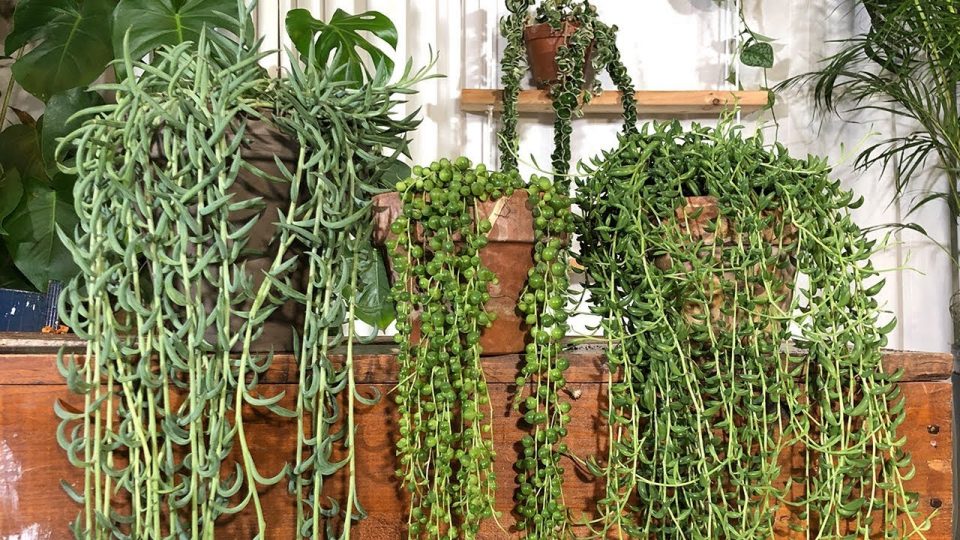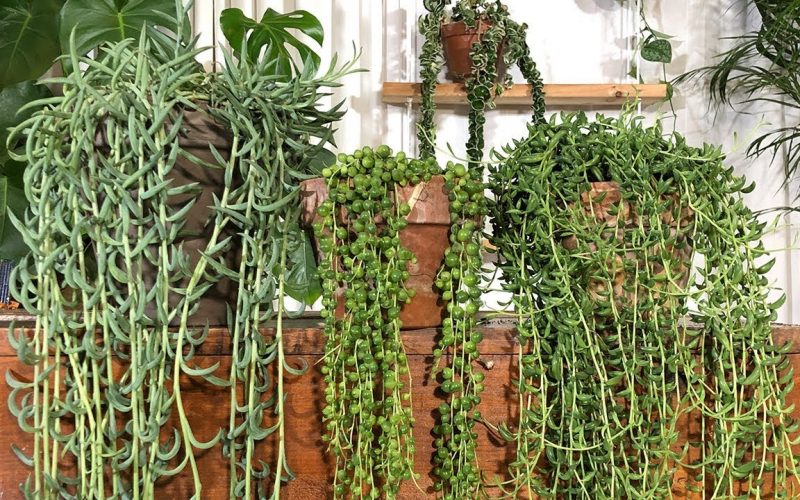String of Bananas whose scientific name is Senecio radicans / Curio radicans is a tropical plant native to South Africa. The plant belongs to the Asteraceae family and it’s a close relative to the String of pearls plant. But in comparison to its relative, this succulent is a fast grower and easy to care for. ‘String of Bananas’ is grown for their interesting foliage rather than for its flowers. The plant blooms during the early spring with Light pink, white flowers.

It is grown both indoors and outdoors but when you grow them indoors, the growth rate is moderate but outdoors the growth rate is comparatively faster. The banana-shaped glossy leaves of this plant tend to trail down faster than it spreads. A mature plant could be 36 inches long and you can place them in a hanging pot or put it in a decorative pot and place it on a table or shelf. Be careful if you are growing them outdoors as they are not frost-tolerant, so place them in a spot that is mostly warm throughout the year.
‘String of Bananas’ Care
- Light requirements: The major part of caring for this plant is providing it with at least 6 hours of bright direct light every day. String of bananas also grows well under grow lights if required. Put them in a spot indoors where it receives light otherwise it may look leggy and the banana-shaped leaves will lose their charm over time. If you see Sparse foliage, it’s an indication that the plant is receiving less light, and if you see leaves switch brown tips, it means the plant is under too much sun exposure.
- Water requirements: The succulent needs less water and it is considered drought tolerant. But generally, the soil needs to be watered whenever you feel the upper layer is dry. During the summers and springs which is the blooming period for this plant, it needs water once a week. When the plant enters the dormancy period, watering the plant once every two weeks will suffice. It is better that you do not overwater this plant as it may cause root rot, being underwater can be somehow fine for the plant.
- Soil requirements: For this plant, you may need well-drained soil to avoid any root rot to the plant. You can buy the traditional soil mix from the store or you can use the cactus mix which is the most favorable soil for this plant. You can even make soil by yourself by mixing two parts of potting soil, one part of perlite along with one part of sand or pumice. The mixture will provide an adequate amount of drainage to your plant. You can add compost to add more nutrients to the soil.
- Temperature & Humidity requirements: The string of bananas is native to the South African region where they grow in hot and dry climates all year. But, they thrive really well with the humidity and temperature levels at homes. Make sure that you keep the plant away from air conditioning and heating vents. Also, keep the plant inside if the temperature in your region goes below 30 degrees Fahrenheit. The plant can survive temperatures above 110 degrees Fahrenheit as well but make sure it is not exposed to extreme temperatures.
- Fertilizer requirements: Just like most succulents, this plant also is not a great fond of regulating fertilizer feedings. However, you can use light fertilizer feeding during the summer and springtime when the plant is blooming. Use organic fertilizers made of worm compost, liquid kelp, and fish emulsion to feed the plant.
‘String of Bananas’ Propagation
The process of propagation is quite simple as well and you can perform the steps mentioned below with healthy cuttings of the plant. Here’s how to perform the steps:
- When you are trimming string of bananas, cut off a healthy vine that is at least 2 inches above the stem.
- Now go for pruning by removing the lower leaves which is around the cut end.
- Now it’s time to dry those leaves, you can see if the leaves are dry when they form a callus, which usually takes three to seven days.
- Repent the plant in a new pot with good drainage holes, and use the succulent mix or cactus mix to encourage good drainage.
- Water the soil to keep it damp until you see the growth of new roots from your cuttings. Make sure you water whenever the soil gets dry.
Key Takeaways
Although the plant is easy to care for, there are several things that need to be taken into consideration. Here are some points that will help you in keeping your plant healthy at home.
- Although the plant is not very prone to diseases, the common house pests may interrupt the growth of the plant. Suck sap, like mealybugs, aphids, spider mites, and scale insects are the most common pests that attack the plant. Early detection and treatment can keep them in control.
- The plant does not need frequent repotting, you can re-pot it every two years. The best time to do so is in summers and springs when the plant is blooming. Make sure that you are being delicate while doing the repotting process as the stem breaks off if you go hard with it.
- If you see a string of bananas drying up, dying, or turning brown, it is an indication that the plant is exposed to too much direct sun which is causing sunburn to the foliage. Also, keep a check that you do not overwater the plant which may cause root rot.
Frequently Asked Questions
Q1: Is String of Bananas toxic to humans and pets?
Yes, the string of banana plants is toxic to pets and mildly toxic to humans if ingested.
Q2: How often should you water the string of banana plants?
During the blooming period, you can water it once every week but make sure that the soil is dry before watering.
Q3: How to care for a string of banana plants?
Do not overwater them, keep them in well-drained soil and place them in a spot where they receive several hours of direct light for good growth.

